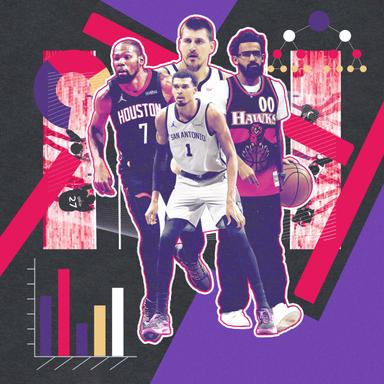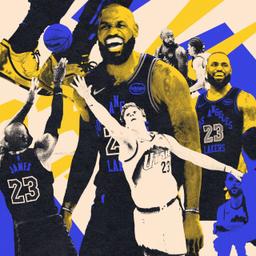
During the third quarter of a mundane November matchup against the Golden State Warriors, Phoenix Suns backup guard Collin Gillespie is standing near the top of the key as Devin Booker knocks down a free throw. When the ball drops through the net, the rebounders break off the lane lines to jog downcourt, but Gillespie goes the other way. He veers toward the baseline near Golden State’s bench, attaching himself to Warriors guard Brandin Podziemski in the backcourt. It’s a small maneuver, but a meaningful one. Gillespie and the Suns have made it a point to pressure opposing ball handlers full court this season.
“It’s one way for me to stick in the league,” Gillespie tells me. “I got to play hard. I got to compete. That's probably my calling card as an NBA player.”
On this possession, Gillespie’s defense won’t show up in the box score. Podziemski uses a Draymond Green screen to shake Gillespie and bring the ball across half court. But the cumulative effect of plays like this has paid dividends for Phoenix in the early part of the 2025-26 season. The Suns are applying backcourt pressure more than three times as often as they did last season, according to Synergy Sports. Their overall defense has improved, their opponent turnover rate has spiked, and they’ve jumped out to a surprising 9-6 start behind a newfound feistiness.
The Suns are hardly alone in this; the rise of full-court pressure has been one of the most pervasive trends of the NBA season’s first month. Leaguewide, full-court pressure has increased substantially. Two-thirds of the NBA’s teams are pressing more than they did last year, per Synergy, with the Portland Trail Blazers leading the way. “If you're playing defensively full court, you're speeding the game up and getting a team to play faster than they like,” says Rick Carlisle, whose Pacers harassed guards like Jalen Brunson and Shai Gilgeous-Alexander in the backcourt during their improbable 2025 playoff run. “That can be uncomfortable, and there can be turnovers.”
The press is also inextricable from the transformation of basketball over the last two decades, in which the abolition of hand checking, the explosion of pace, and the proliferation of long-range shooting have given ball handlers the upper hand. Can full-court pressure help defenses get back on level ground?
Picking up ball handlers for 94 feet brings a trove of potential benefits. In the best case, a defender nabs a steal in the backcourt that leads to an easy two points. But even in less immediately fruitful scenarios, pressure can wear down an offensive player—especially one who shoulders large playmaking burdens for his team—over the course of a night, giving the pressing team a late-game advantage. At minimum, on a possession-by-possession basis, pressure can slow down the game and limit the flow of the opposing offense.
“Try to make them take at least six seconds off the clock,” says Suns guard Jordan Goodwin of his goal when pursuing a full-court press. “So they start offense like 15 [seconds on the shot clock], instead of 20 or 18.”
The wider adoption of full-court pressure is creating another pathway for defensive-minded players to affect the game. Before he went down with a fracture in his foot, Blake Wesley had carved out a unique role for himself as a defensive menace in Portland. Wesley shot just 20 percent from 3 in six games before his injury, but he averaged 1.7 steals in just 16 minutes per game and made an outsize impact on the Trail Blazers defense. In Phoenix, Gillespie and Goodwin have similarly latched onto the opportunity to dictate the terms of engagement without contributing volume scoring.
“I got to affect the game in a different way, and that's defense,” Gillespie says. “Pressuring the ball, competing at a high level, being scrappy, grabbing rebounds, deflection, steals, all the little things.”
The rise of full-court pressure is also opening up a new cat-and-mouse game between the defenders hounding the ball up the court and the guards tasked with getting past them. For Podziemski, it hearkens back to his AAU days, when many defenses favored full-court pressure over the structure of playing in the half court. The 22-year-old has benefited from fireside chats with a pair of all-time greats at his position. During his rookie season, he peppered teammates Chris Paul and Stephen Curry with questions, which allowed him to learn from two point guards with very distinct styles of combating pressure.
“Chris is more back to the basket, per se, full court,” Podziemski tells me. “He'll just skip, skip, skip, skip you down. Where Steph is like, ‘I'm just going to make one move, maybe two moves, and get past you and then slow down.’ So there's different ways you could do it, and both are effective.”
Against Phoenix, Podziemski relies on both tactics. “If it's a longer guy, usually, I know my quickness, I got that edge per se, so I can just get past them and then just set on my feet,” he says. “If it's a smaller guy, like Collin Gillespie or Dennis Schröder, guys who are smaller, I can use my body and keep my body between them and the ball.”
After beating Gillespie’s pressure up the floor, Podz passes the ball to Curry on the right wing, before the ball finds him again on a curl. With Gillespie still trailing and out of position, Podziemski rams his shoulder into Gillespie’s chest, gets into the paint, and Euro-steps for an easy score.
“If you get by them, it's five-on-four now offensively,” Podziemski says.
Ironically, Golden State’s influence on the game is a catalyst for the current defensive trend. In Curry’s 17 seasons, the Warriors have taken the game out of the paint. Golden State has routinely finished near the top of the league in pace, points, and 3-point shooting on the way to four titles in the past 10 years. Many teams have attempted to emulate the Warriors’ beautiful game, and now they’re searching for ways to disrupt the blueprint altogether.
I ask Warriors coach Steve Kerr if the league’s defensive trends are a response to the offensive explosion he helped create. “Yes,” he says. “And the patterns of the 3-point shooting and the kind of heliocentric offense. So, the Luka [Doncic], James Harden offense—high pick-and-roll, shooters everywhere, get downhill, kick, drive, kick, swing, 3-point shot—that's been the pattern of the league. Between that and pace, teams get into a rhythm, all of a sudden everybody, they're making 3s and it's like, ‘How do you disrupt that?’ And I think full-court pressure is one way of doing it.”
Where is all this going? Will we see even more teams embrace the press, or are NBA guards just too skilled for it to have sticking power? Will pressure lead to a more entertaining product, or will it grind the game down and lead to more fouls? Carlisle believes that the levels we’re seeing now are just the tip of the spear, one manifestation of an NBA that is becoming more physical and more competitive each season.
“This has become a hard-play league,” Carlisle says. “It’s great for the game. It’s great for our fans. People want to see a high compete level, and when players are picking up full court and playing to exhaustion, that glorifies the NBA game.”






